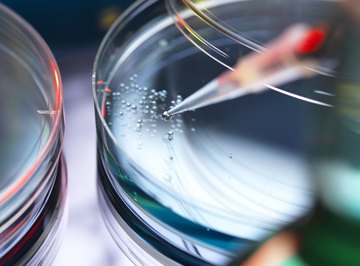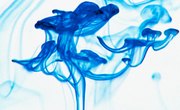
Molds are very simple and common. Molds grow easily, and they usually can be cultivated in the laboratory on a Petri dish with agar and nutrients for mold growth. Further, using a good microscope and proper slide preparation, molds often can be identified to the genus level. The identification of mold on a Petri dish agar surface is a straightforward task.
Observing and Handling Microbial Colonies on Agar
Observe the Petri dish provided and note the number and types (color, size, shape) of colonies present.
Mold colonies possess distinctive features as listed following: fuzzy, cottony, powdery, spreading and thread-like.
Circle with a marker the bottom of the Petri dish under each colony that suggests possible molds. Describe the colonies on agar in a notebook as to distinctive color and any other gross features of what may be a mold. For example, possible mold type—"circular colonies with green powdery surface" or, "raised cottony, fluffy colony with black, peppery-looking dots."
Important features to look for on gross exam, which can be enhanced with a good hand lens, include the distinct threads called "hyphae" (fungus strands) that penetrate and extend through the agar.
Flame the microbiology loop or wire and remove some of the mold growth and spores. The use of two wires or loops promotes removal.
Place loop or wire material portion of "fungus" colony onto slide with a drop of stain, and add a coverslip. Gently press down to flatten potential mold and agar. Use a paper towel dipped into alcohol for pressing. Discard towel and wipe hands with disinfectant and dry.
Observation of Potential Mold from Agar Plate
- Microscope or, minimally, 10-20 X hand lens
- Glass microscope slides
- Coverslips for slides
- Stain, if available, methylene blue or cotton blue lactophenol
- Microbiology handle and loop, or microbiology handle and wire
- Bunsen or alcohol flame
- 70 percent isopropanol to disinfect slides and kill mold as needed
- Discard dish or jar, with isopropanol, for contaminated slides and coverslips
Check plates carefully. Molds grow more slowly than bacteria and may appear only after five to 10 days after first use of the Petri dish.
Discard and disinfect slides and coverslips into a jar or dish containing isopropanol. This act will kill spores and hyphae of the molds.
Wash hands thoroughly with soap and water after handling Petri dishes and slides.
Place the slide onto the microscope stage. Focus with low power (typically 100X). Focus up and down until something is visible in the microscopic plane of focus. To facilitate the focusing process, move the slide slightly while focusing. This permits visualization of the plane of focus.
Depending on the organism, at the very least hyphae (the singular is hypha) mold threads should be obvious. These hyphae look like cotton fibers. If you see hyphae, you have identified a mold colony. Another name for mold is filamentous fungus.
Spores, or conidia, may be present. These spores or conidia may be spherical, elliptical or angular, and they range in color from almost clear to brown, green, black or even purple.
The presence of hyphae and spores, or condia, indicates you have a sporulating mold. Some fungi do not produce sopes on agar media. Nevertheless, the threads indicate it is a mold.
Things You'll Need
Tips
Warnings
References
